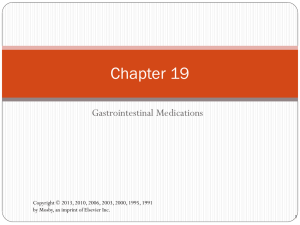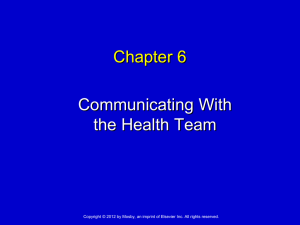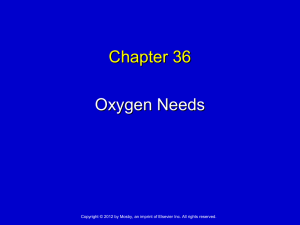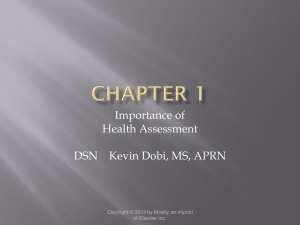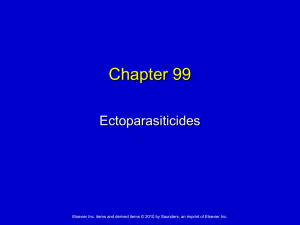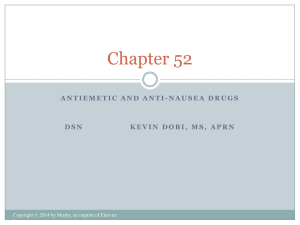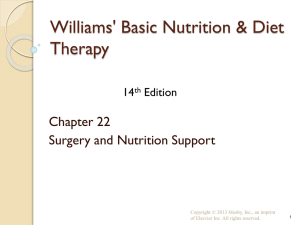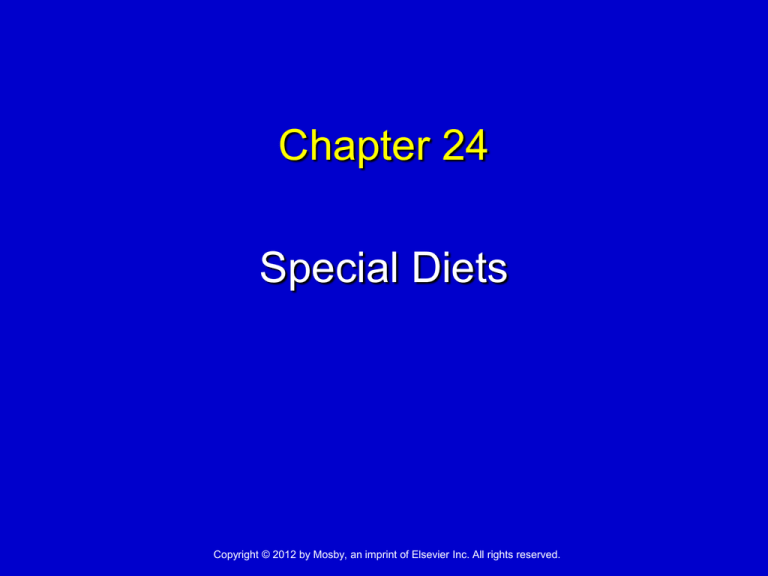
Chapter 24
Special Diets
Copyright © 2012 by Mosby, an imprint of Elsevier Inc. All rights reserved.
Special Diets
Doctors may order special diets:
For a nutritional deficiency or a disease
For weight control (gain or loss)
To eliminate or decrease certain substances in
the diet
The health team considers the need for
dietary changes, personal choices, religion,
culture, and eating problems.
Regular diet, general diet, and house diet
mean no dietary limits or restrictions.
Copyright © 2012 by Mosby, an imprint of Elsevier Inc. All rights reserved.
Slide 2
Special Diets (cont’d)
The sodium-controlled diet
Sodium causes the body to retain water.
• The heart has to work harder. The extra
workload can cause serious problems or
death.
Sodium control decreases the amount of sodium
in the body.
The doctor orders the amount of sodium allowed.
Sodium-controlled diets:
•
•
•
Omitting high-sodium foods/salt used in cooking
Not adding salt to food at the table
Used for Hypertension, ht disease, kidney disease
Copyright © 2012 by Mosby, an imprint of Elsevier Inc. All rights reserved.
Slide 3
Special Diets (cont’d)
Diabetes meal plan
A meal plan for health eating is developed.
• Consistency is key-same amount of fat, protein, carbs
The meal plan involves:
• The person’s food preferences
• Calories needed
• Eating meals and snacks at regular times
You need to:
• Serve meals and snacks on time.
• Always check what was eaten.
• Report what the person did and did not eat.
• Report changes in the person’s eating habits.
Copyright © 2012 by Mosby, an imprint of Elsevier Inc. All rights reserved.
Slide 4
Special Diets (cont’d)
The dysphagia diet
Dysphagia means difficulty swallowing.
Food/fluid thickness is changed to meet the
person’s needs.
Thickened liquid-pureed with liquid until
consistency of baby food
Medium thick (Nectar) consistency-thickness of
nectar or V8 juice
Extra thick (honey) consistency-mounds a bit on
spoon
Yogurt like-thick and holds its shape
Puree-no lumps, mounds on plate
Copyright © 2012 by Mosby, an imprint of Elsevier Inc. All rights reserved.
Slide 5
Special Diets
Pureed diet
Used for persons with swallowing difficulties
Consistency like mashed potatoes
Copyright © 2012 by Mosby, an imprint of Elsevier Inc. All rights reserved.
Slide 6
Dysphagia Diet
Doctor, speech-language pathologist,
occupational therapist, dietitian, and nurse
choose food thickness.
When feeding the person with dysphagia, you
must:
• Follow aspiration precautions and the care
plan.
• Report changes in how the person eats.
• Observe for signs and symptoms of
aspiration: choking, coughing, or difficulty
breathing during or after meals, and abnormal
breathing or respiratory sounds.
Copyright © 2012 by Mosby, an imprint of Elsevier Inc. All rights reserved.
Slide 7
Special Diets
Clear Liquid diet
Include foods that are liquid at room temperature
and leave small amounts of residues. They are
non-gas forming and non-irritating.
Examples include: water, tea, coffee, sprite,
gelatin, clear fruit juice, clear broth, popsicles
Used for person right after surgery or with nausea
and vomiting
Copyright © 2012 by Mosby, an imprint of Elsevier Inc. All rights reserved.
Slide 8
Clear liquid diet
Copyright © 2012 by Mosby, an imprint of Elsevier Inc. All rights reserved.
Slide 9
Special Diets
Full-liquid diet
Includes foods that are liquid at room temperature
or melt at body temperature
Used for persons advancing from a clear liquid
diet post-operatively, for those unable to chew or
swallow
Foods include: custard, eggnog, strained soups,
strained vegetables, milk, strained cereal, ice
cream, pudding, yogurt
Copyright © 2012 by Mosby, an imprint of Elsevier Inc. All rights reserved.
Slide 10
Full liquid diet
Copyright © 2012 by Mosby, an imprint of Elsevier Inc. All rights reserved.
Slide 11
Special Diets
Mechanical soft
Includes semi-solid foods that are easily digested
Used to advance from full liquid diet after surgery
and for chewing problems or GI issues
Foods allowed: all liquids; meat, chicken or fish
that is shredded; soft cheeses, soft bread without
crust, pureed cooked vegetables, soft fruit,
pudding
Copyright © 2012 by Mosby, an imprint of Elsevier Inc. All rights reserved.
Slide 12
Mechanical soft diet
Copyright © 2012 by Mosby, an imprint of Elsevier Inc. All rights reserved.
Slide 13
Special Diets
Bland diet
Mechanically and chemically non-irritating foods
Low in roughage, moderate temperature, no
spices
Used for persons with GI disorders or after
abdominal surgery
Includes pasta, white bread, cottage cheese,
creamed soups, plain cereals
Copyright © 2012 by Mosby, an imprint of Elsevier Inc. All rights reserved.
Slide 14
Special Diets
Other diets include high fiber, high calorie,
calorie controlled, high iron, high protein, fat
controlled.
Bonus: what type of patient do you think you
might see a high protein diet used for?
Copyright © 2012 by Mosby, an imprint of Elsevier Inc. All rights reserved.
Slide 15
Fluid Balance (cont’d)
Common special fluid orders are:
Encourage fluids: the person drinks an increased
amount of fluids.
Restrict fluids: fluids are limited to a certain
amount.
Nothing by mouth (NPO): the person cannot eat
or drink anything.
Thickened liquids: all fluids are thickened,
including water.
Copyright © 2012 by Mosby, an imprint of Elsevier Inc. All rights reserved.
Slide 16

